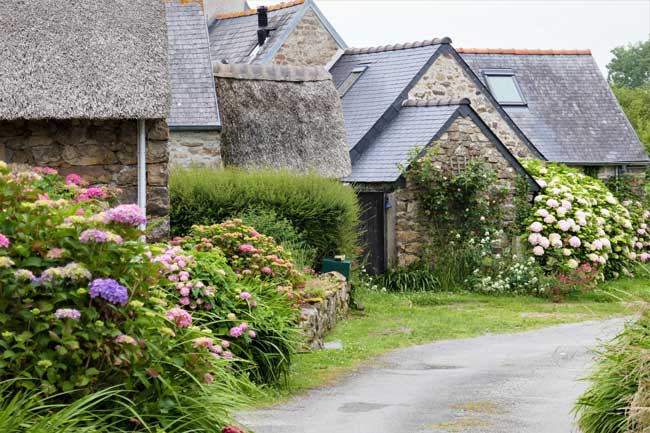
Not many Americans make it to Brittany. France’s northwest cul-de-sac that reaches out into the Atlantic Ocean like a crooked thumb is just too far off the traditional loop trip, the tourist route that takes busloads of visitors from Paris to the castles of the Loire Valley, then up to the Normandy beaches.
Travel in Brittany
The wilds of Brittany are out of the way, and very different from the rest of France. Brittany has its own language, its own music, its own food and drink and its own laws.
Much like Wales and Scotland are to the U.K., Brittany is independent with a strong Celtic background steeped in tradition and legends. Oh yes, and it is wild.
If you see a picture of a lighthouse about to be engulfed by a towering wave, that’s Brittany. The coast is rugged, rocky and huge. One-third of France’s coastline is in Brittany.
The villages are all made of stone, but the coldness is set off by brilliant marine-blue shutters and doors and hundreds of colorful flower boxes and gardens.
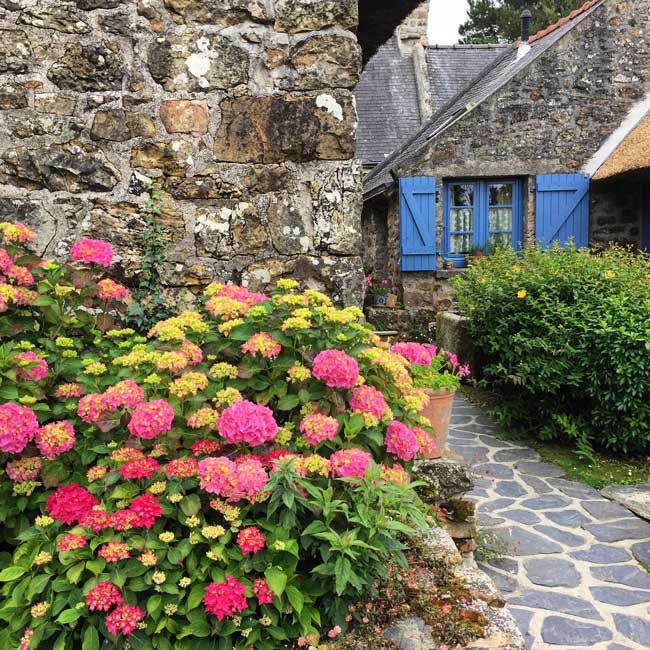
The bays are protected by fearsome castles and fortresses, the tides are huge, leaving boats and even towns dry-docked at low tide. The people are tough and stoic, as is anyone who makes their living from the sea.
And yet, Brittany is spectacularly beautiful. It’s a rare calendar of France that is not filled with colorful pictures of doors, windows, flower baskets and gardens from Brittany, where the gulf stream provides a temperate climate that can support a wide assortment of plants and even palm trees.
So when my brother, who has lived in France for 40 years and knows every corner of it, said, let’s spend a week in Brittany, the only answer was, why not? Here’s some of what we discovered.
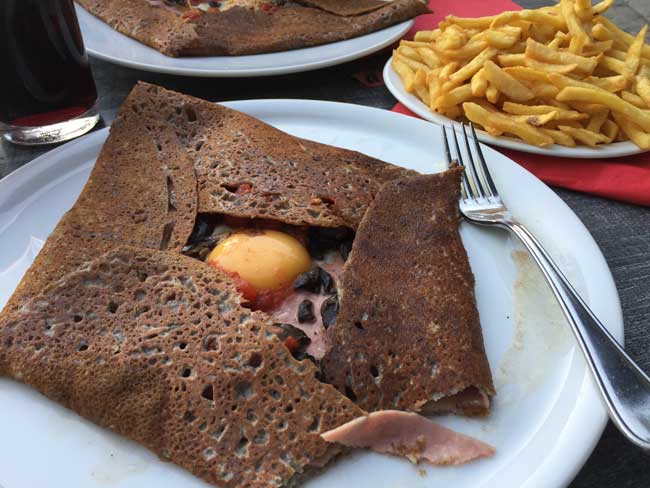
Cuisine in Brittany
Crêpes are the specialty of Brittany, or more specifically, galettes, which is a version popular in upper Breton made with buckwheat, eggs, milk and melted butter, made into a thin dark pancake and then filled with everything you can think of.
The traditional is ham, egg and cheese, but you can get them stuffed with scallops, shrimp, mushrooms and more (but please limit yourself to four fillings, they say, or you will ruin the taste of the crepe itself).
The menus offer baffling combinations of ingredients, but you can just order individual crepes and have them filled with whatever you want.
Seafood is naturally the other dish, especially oysters. The seafood markets are colorful and exciting places filled with strange sea life you have never seen, let alone eaten. There are fresh blue lobsters (yes, lobsters of Brittany are blue), crabs, scallops and mussels.
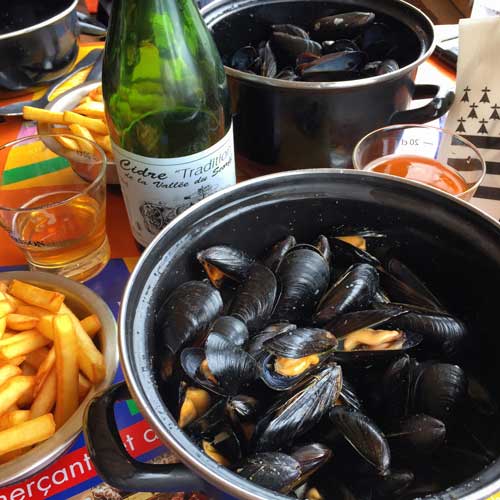
At the more expensive cafes, you will ogle at seafood towers — gigantic multi-level platters for two of lobster, fist-sized shrimp, oysters, and crab legs, at which a French couple will pick and chew for hours.
More reasonably priced and available everywhere is the other dish of Brittany, moules marinieres — mussels steamed in white wine and served with a mound of fresh frites, (never call them French fries!).
Pick your restaurant by strolling by the cafes and examining the fries – some are fresh cut, but some to avoid look frozen and machine cut.
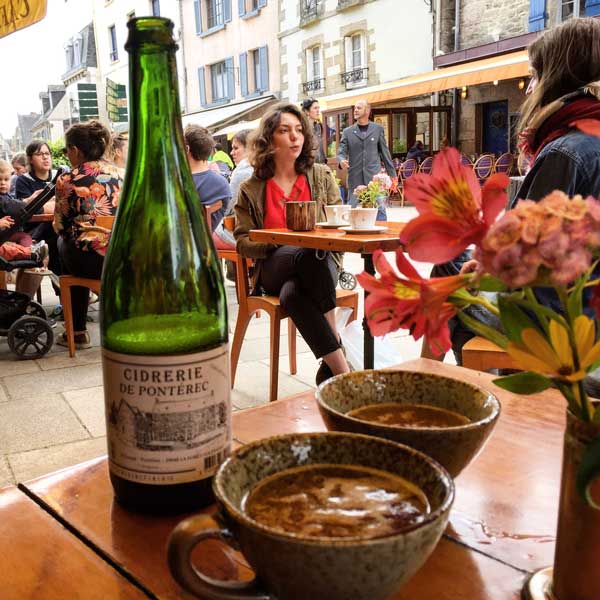
Breton Hard Cider
The drink of choice (especially with crepes) is Breton hard cider, a natural sparkling alcoholic beverage made from apple juice and served in earthenware cups.
There are hundreds of local farms producing them – the best local ones come in bottles that look like champagne bottles with a wired cork. The taste is unlike any commercial cider you have had – closer to the wine family than the beer.
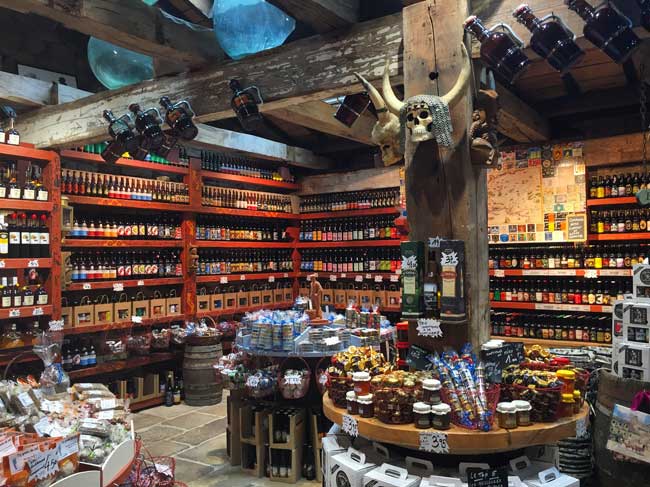
Beer in Brittany
Speaking of which, there are 500 different named beers made in Brittany; we visited one shop that apologized for only carrying 195. Local beers are strong and with many Belgian and sour style varieties.
To me the labels — colorful, crazy and artistic — were more interesting than the beers. There are some Breton wines, but since Brittany borders the Loire Valley, one of the most outstanding wine producing areas of the country, there are many reasonably priced local white wines from nearby.
Historic Towns of Brittany
Because Brittany is a rural area with simple pleasures and few cities, my brother, who has visited many times, suggested staying in historic towns rather than cities. These towns offer free parking, are perfect for day trips to nearby villages and the coast, and are easy to navigate, yet offer ample choices for dining in the evening.
Since the sun doesn’t set in Brittany in June and July until 10 p.m., it’s wise to remember when strolling around that many restaurants stop serving at 9:30 p.m. We stayed two nights in four places, each very different.
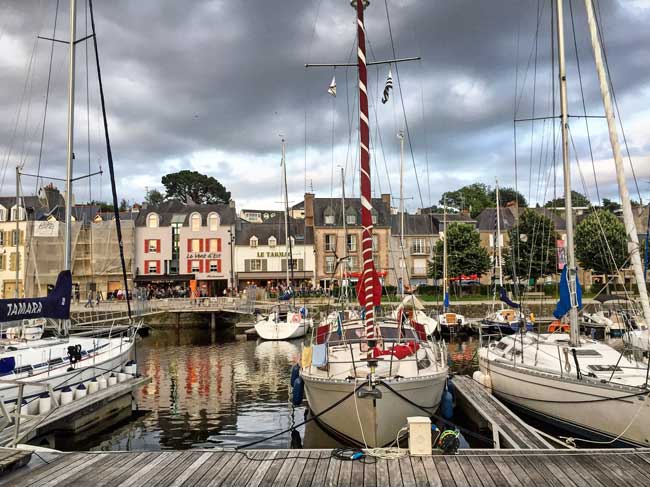
Vannes
On a beautiful bay on the south coast, Vannes boasts of having 2,000 years of history. And while the town is filled with city walls, medieval half-timbered houses, and wonderful cobblestone streets, it is also a youthful place, with contemporary looking cafes, attractive young couples, and a huge downtown marina lined with boats and bars.
The castle moat is now a flower garden with a stream flowing through it. There are hundreds of boats to enjoy, and the night we were there, a pipe band was practicing, filling the air with Breton Celtic music (with a few Scottish and Irish tunes thrown in. They all sound pretty much alike, but wonderful.).
Concarneau
France is filled with literally hundreds of castles, fortresses and ruins of city walls, but it is rarity to find an intact fortified island that still has a town inside it. Concarneau is just that. The towering ramparts are surrounded (at high tide) by water.
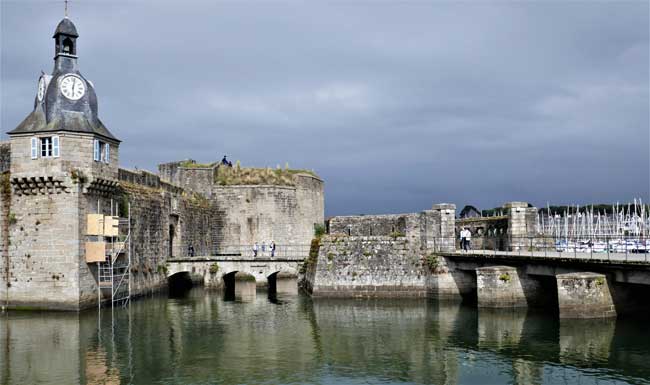
You enter the fortified city across a long drawbridge, pass through two impressive gates, and wander into an historic wonderland of half-timbered buildings, cafes and backstreets. By day, it’s of course a little touristy, as any place this preserved would be.
But come evening, the shops close, the cafes dwindle down (most of the town’s restaurants are located outside around the bay), and you can have the rampart walls pretty much to yourself.
The town looks quite a bit like Canada’s Quebec City, which of course, it should since it’s from the same time period and built by essentially the same people. Most castles and fortresses are closed at night, but this one is open 24-7, so you can enjoy the town center by moonlight.
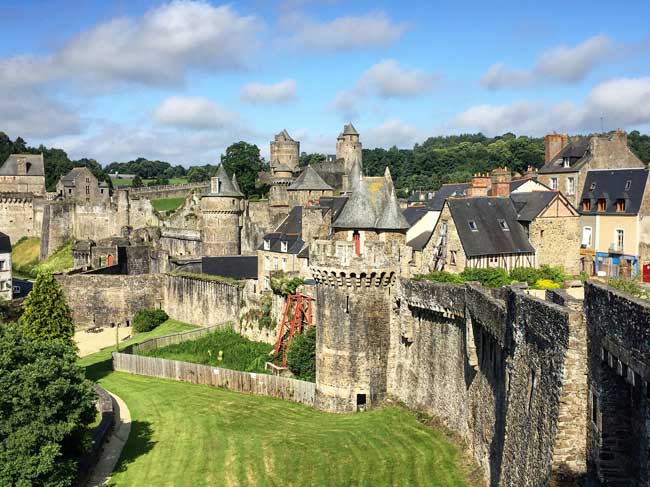
Fougeres
This is the storybook castle people dream of. The circular curtain wall is intact and bristling with towers. It sits at the bottom of a hill, so there are time-traveling views that haven’t changed in centuries into the fortress, which is brilliantly lit at night.
Walking around the 80-foot-high stone walls in the evening, passing by a working gristmill that has four waterwheels, and dining on crepes and cider along the moat in the shadow of the drawbridge is a magical experience.
The town sits near the border of Normandy and Brittany, and naturally has a wild and bloody history, but is a quiet place today filled with walks, flowers, and happy birds who swoop along the castle walls at dusk.
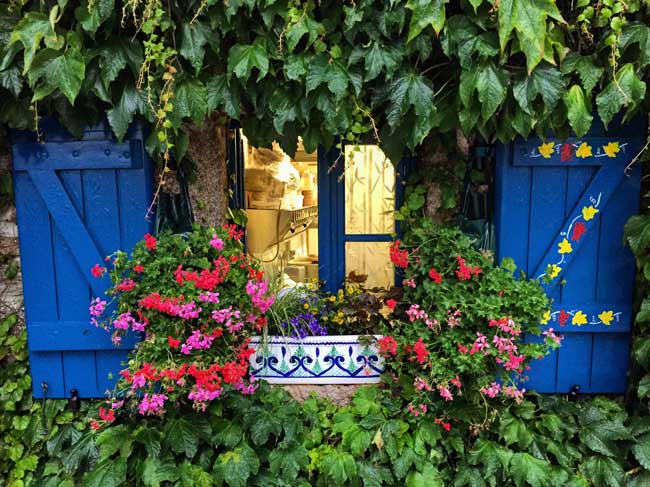
Saint-Malo
This is the ultimate pirate town, a walled city surrounded by forts that was home to France’s most famous corsairs (legal pirates, authorized by the King to fight the British).
It was the home of Jacques Cartier, who founded Quebec, and because of its military importance, it has some of the evilest looking fortresses in France, most notably the National Fort, which can only be entered at low tide.
Sadly, 80 percent of the town was destroyed by American bombers in World War II, but it is the only town in France that was completely rebuilt to resemble its historic appearance.
Today, it is also a major beach town resort. Inside the walls, there are pirate shops, pirate themed cafes and statues of pirates. Outside, there are beaches, boats, swooping seagulls, and corsair ships darting around the harbor, easily spotted because of their distinctive blood red triangular sails.
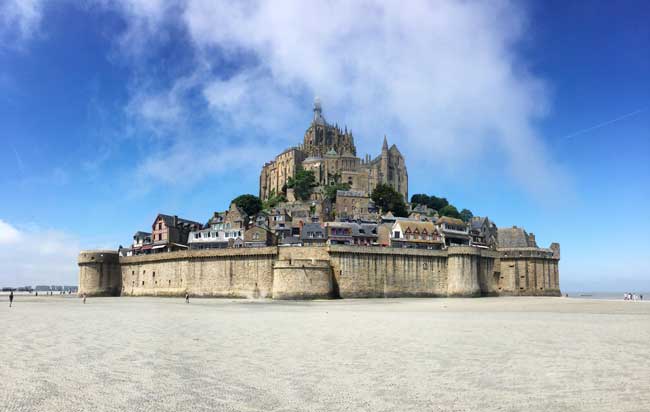
Saint-Malo is a wonderful base in Brittany, and also within easy striking distance of one of Europe’s top tourist attractions, Mont St-Michel. Technically, Mont St-Michel is just a mile over the Brittany border and in Normandy.
While you should certainly visit this 1,000-year-old abbey and fortress that floats above the water and sand and is one of the great and most famous sights of the world, be warned that it is crowded. When you tire of its armies of tourists, the packed narrow streets, and the high prices, nearby Saint-Malo will give you a peaceful evening retreat.
If you’re lucky and hit Saint-Malo at low tide and in a twilight fog as we did, the walk across black rock and sand to the looming National Fort with the tricolor floating above it, will be as memorable as any glimpse of Mont St-Michel.
Just remember, the tides come in faster than a galloping horse. Always keep a wary eye on the horizon. The sea is filled with the dead bodies of those who didn’t.
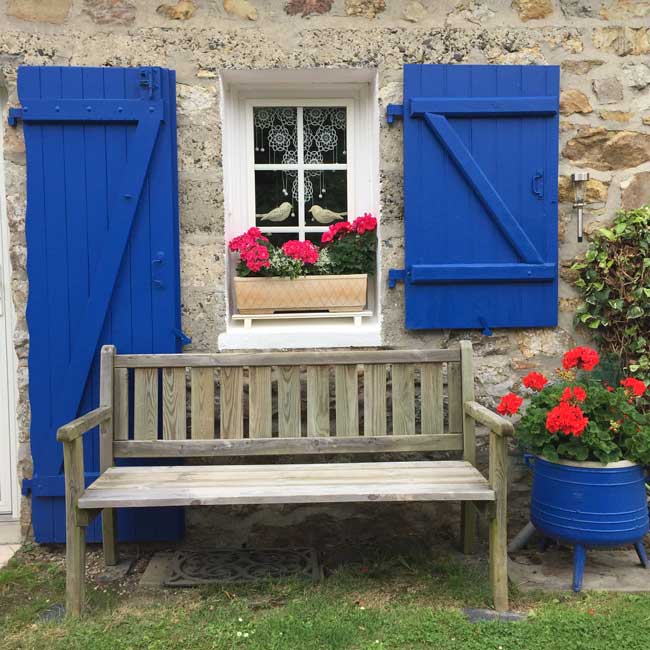
Small Towns of Character
Of course, one of the best reasons to visit Brittany is to enjoy its many flower-covered, stone villages and small towns. France has been in the preservation business for hundreds of years.
There are national designations such as “Plus beaux villages de France” (the most beautiful villages of France) and “Small Towns of Character.”
These highly contested and only awarded to towns that have retained a coherent architecture and a sense of place, where the residents have worked together for decades (and sometimes centuries!) to avoid power lines, modern buildings and garish advertising.
They have strict building codes that must be followed. It’s a rare shutter or door anywhere in Brittany that is not painted marine-blue. Most of these villages and towns are pedestrian only and filled with the most lavish of gardens.
Of course, they are often crowded. But come early morning and twilight, and you can have them to yourself.
English speaking tourist offices in town and city centers can help you find these villages and provide excellent free maps, but we found Google Maps to work just as well. Part of the fun is discovering them on your own, but here are some we toured that are worth a journey:
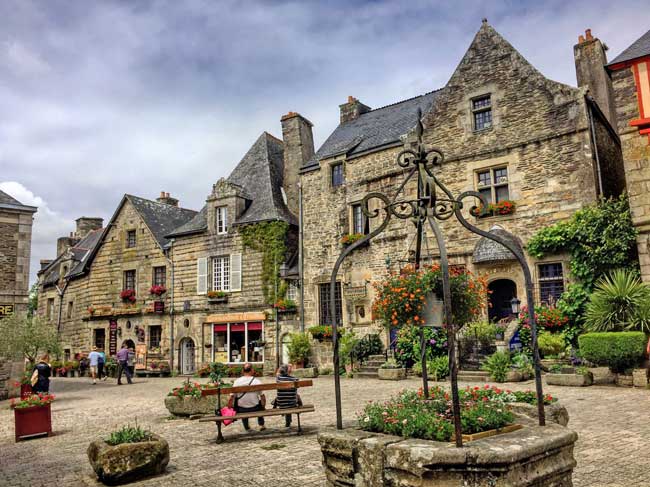
Locronan
This is the most famous village, and with good reason. It’s stunning. You park on the edges and walk into the village square lined with stone buildings from the 15th century. This was the center of the sailcloth industry for 300 years. Since the 19th century, it’s architectural beauty has been recognized and preserved.
Rochefort-en-Terre
Famous for its geraniums, this 16th-century feudal town stands on a rocky, fortified spur with steep alleyways leading from the lower town up to the former citadel. The view, looking down on the slate roofs of the village, where whiffs of blue smoke curl from the chimneys, is like walking into another world.
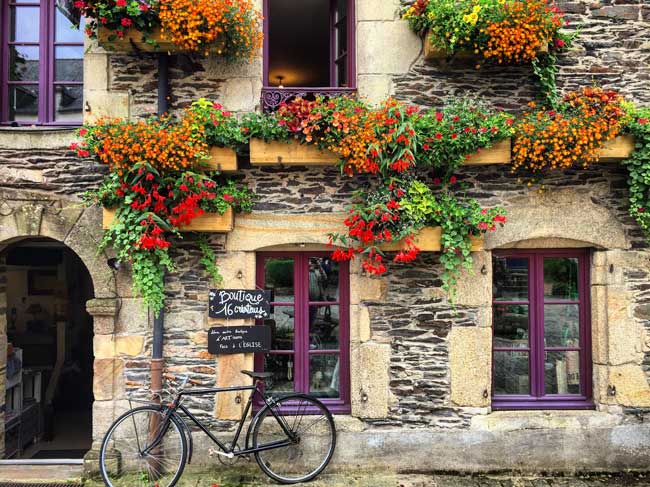
Pont-Aven
This quayside village has always attracted artists, including Paul Gauguin, who lived here and did 14 paintings of village scenes.
Camaret-sur-Mer
Few Americans make it to this extreme far west corner of the Crozon peninsula, but one who did visit this ship building town in the early 1800s, was American inventor Robert Fulton. This was where he tested the first underwater propellers.
Fulton would later become world famous for inventing the first steamboat and sailing it up the Hudson River in New York, where he steamed past the little village of Hastings-on-Hudson, where my brother and I grew up.
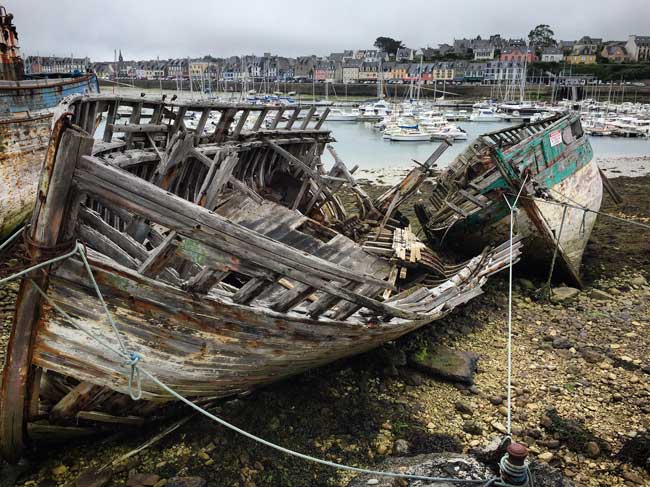
What a strange coincidence to run into Fulton here in outer-France, surrounded by the Atlantic Ocean with a wild coastline, a Vauban fortress tower and a harbor filled with picturesque wrecks of wooden boats. The town feels like the end of the world. And that’s a good thing.
Author Bio: Rich Grant is a freelance travel writer in Denver, Colorado and a member of the Society of American Travel Writers and the North American Travel Journalists Association. He is, along with Irene Rawlings, co-author of “100 Things to Do in Denver Before You Die,” published by Reedy Press in 2016.
